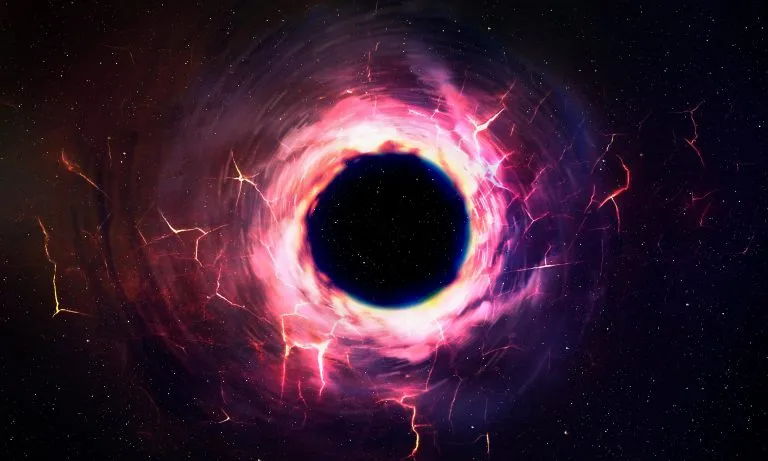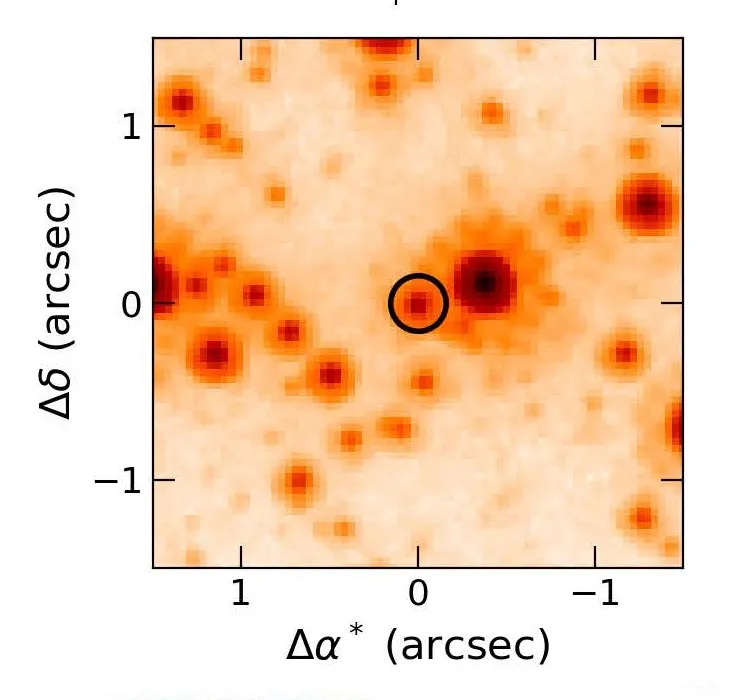When massive stars reach the end of their lives and explode in supernovae, they leave behind a black hole. It is estimated that about one in every 1000 stars is large enough to give birth to a black hole. It is estimated that there are 100billion to 400billion stars in the Milky way, and there may be a large number of black holes in the whole Milky way However, the nature of black holes makes them difficult to detect, especially when they are isolated
After all, black holes have such strong gravity that light cannot escape, so astronomers usually detect them through their gravitational influence on other celestial bodies or the radiation generated by the surrounding materials they swallow. If there were no nearby celestial bodies or accretion materials, there might be hundreds of millions of black holes in the entire Milky way, but astronomers could hardly see them.

If, as astronomers believe, the death of large stars will leave black holes, there should be hundreds of millions of black holes scattered in the Milky way. The problem is that isolated black holes are invisible.
Now, a team led by astronomers at the University of California, Berkeley, has discovered for the first time what may be a free floating black hole. They have observed that a distant star is brightened because its light is distorted by the object's strong gravitational field -- the so-called gravitational microlens.
The team led by graduate student Casey Lam and Jessica Lu, associate professor of astronomy at the University of California, Berkeley, estimated that the mass of this invisible compact object is 1.6 to 4.4 times that of the sun. Because astronomers believe that the remnant of a dead star must weigh more than 2.2 solar masses to collapse into a black hole, researchers at the University of California, Berkeley, warned that the object might be a neutron star, not a black hole. Neutron stars are also dense and highly compact objects, but their gravity is balanced by the internal neutron pressure, thus preventing further collapse into black holes.
Whether it is a black hole or a neutron star, this object is the first dark stellar remnant discovered - the "ghost" of the star - wandering in the Milky way without pairing with another star.
"This is the first free floating black hole or neutron star discovered by gravitational microlens," Lu said. "Through microlenses, we can detect these lonely, compact objects. I think we have opened a new window for these dark objects, which cannot be seen in other ways."
Determining how many of these compact objects are in the Milky way will help astronomers understand the evolution of stars -- especially how they die -- and our Milky way, and perhaps reveal whether any invisible black holes are primitive black holes, which some cosmologists believe were produced in large quantities during the big bang.
The analysis of Lam, Lu and their international team has been accepted and published in Astrophysical Journal newsletter 》Up. The analysis includes four other microlens events that the team believes were not caused by black holes, although two of them may have been caused by white dwarfs or neutron stars. The team also concluded that the number of black holes in the Milky way might be 200million - about the same as most theorists predicted.
Same data, different conclusions
It is worth noting that a competitive team from the Space Telescope Science Institute in Baltimore (STScI) analyzed the same microlens event and claimed that the mass of this compact object is closer to 7.1 solar masses, which is indisputably a black hole. A paper describing this analysis by the STScI team led by Kailash Sahu has been accepted and published in the Journal of astrophysics.
Both groups used the same data: photometric measurements of the brightness of distant stars when distorted or "lensed" by ultra compact objects, and astrometry of the movement of distant stars in the sky due to the gravitational distortion of lensed objects. Photometry data come from two microlens surveys: the optical gravitational lens experiment (ogle), which uses a 1.3m telescope of Warsaw University in Chile, and the microlens observation (MOA) experiment in astrophysics, which is installed on a 1.8m telescope of Osaka University in New Zealand. Astrometric data from NASA's Hubble Space Telescope. STScI is responsible for managing the scientific project of the telescope and conducting its scientific operation.
Because both low light level surveys have captured the same celestial body, it has two names: moa-2011-blg-191 and ogle-2011-blg-0462, abbreviated as ob110462.
Although such surveys have found about 2000 stars brightened by microlenses in the Milky way every year, the addition of astrometric data has enabled the two teams to determine the mass of this compact object and its distance from the earth. The team led by the University of California, Berkeley, estimated that it lies 2280 to 6260 light-years away, in the direction of the center of the Milky Way galaxy, near the large bulge surrounding the massive black hole in the center of the Milky Way galaxy.
The STScI team estimates that it is located about 5153 light-years away.

"Looking for a needle in a haystack"
In 2020, when the STScI team preliminarily concluded that the five microlens events observed by Hubble - all of which lasted more than 100 days, so they may be black holes - may not be caused by compact objects after all, Lu and Lam became interested in this object for the first time.
Lu, who has been searching for free floating black holes since 2008, believes that these data will help her better estimate their abundance in the Milky way, roughly between 10million and 1billion. So far, star sized black holes have been found only as part of binary systems. Black holes in binary stars can be seen in X-rays when the matter in the star falls on the black hole, or through the recent gravitational wave detectors, which are sensitive to the merger of two or more black holes. But these events are rare.
"Casey and I saw the data, and we were very interested. We said, 'Wow, there are no black holes. It's amazing,' although there should be," Lu said. "So we began to study these data. If there were no black holes in the data, it would not be consistent with our model of how many black holes there should be in the Milky way. Our understanding of black holes must change - either their number, or their speed of motion, or their mass."
When lam analyzed the photometry and astrometry of the five microlens events, she was surprised to find that one ob110462 had the characteristics of a compact object. The lens object looks very dark, so it is not a star; The star brightened for a long time, nearly 300 days; The distortion of the position of the background stars is also persistent.
Lam says the length of the lens event is the main clue. In 2020, she showed that the best way to search for black hole microlenses is to look for very long events. She said that only 1% of detectable microlens events may come from black holes, so looking for all events is like looking for a needle in a haystack. However, Lam calculates that about 40% of low light level events lasting more than 120 days may be black holes.
Lam said: "How long the brightening event lasts implies the mass of the foreground lens that bends the light of the background star. The long event is more likely to be caused by the black hole. However, this is not a guarantee, because the duration of the brightening event depends not only on the mass of the foreground lens, but also on the relative motion speed of the foreground lens and the background star. However, by simultaneously obtaining the measurement of the surface position of the background star We can confirm whether the foreground lens is really a black hole. "
According to Lu, the gravitational effect of ob110462 on the light of the background star is surprisingly long. It took about a year for the star to brighten to its peak in 2011, and then about a year for it to darken and return to normal.
More data will distinguish between black holes and neutron stars
To confirm that ob110462 was caused by a super compact object, Lu and Lam requested more astrometric data from Hubble, some of which arrived in October last year. These new data show that 10 years after the event, the position changes of stars caused by the gravitational field of the lens can still be observed. Further Hubble observations of the microlens are tentatively scheduled for autumn 2022.
The analysis of the new data confirms that ob110462 may be a black hole or a neutron star.
Lu and Lam suspect that the different conclusions of the two groups are due to the different measurements of the relative motion of foreground and background objects by astrometry and photometry data. The astrometric analyses of the two groups were also different. The team led by the University of California at Berkeley believes that it is still impossible to distinguish whether the object is a black hole or a neutron star, but they hope to solve this difference in the future through more Hubble data and improved analysis.
"Although we would like to say that it is a definite black hole, we must report all permitted solutions. This includes both low mass black holes and possibly even a neutron star," Lu said.
"If you can't believe the curve and brightness of light, then this shows some important problems. If you don't believe the relationship between position and time, then it shows some important things," Lam said. "So, if one of them is wrong, we must understand the reason. Or another possibility is that what we measured in both sets of data is correct, but our model is incorrect. The photometric and astrometric data are generated from the same physical process, which means that the brightness and position must be consistent with each other. Therefore, there is a lack of something."
The two teams also estimated the velocity of objects with ultra compact lenses. Lu/lam team found a relatively calm speed, less than 30 km / s. The STScI team found an abnormally large velocity, namely 45 km / s, which it interpreted as that the so-called black hole received additional stimulation from the supernova that produced it. Lu explained that her team's estimate of low velocity may support a new theory that black holes are not the result of supernovae -- this is the mainstream hypothesis today -- but from failed supernovae.